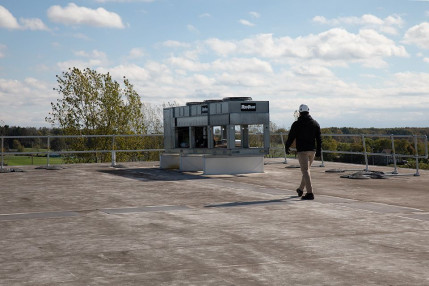The Hierarchy of Fall Protection: What It Is and How to Use It

Choosing the right fall protection is like choosing the right smoker for a barbecue. Sure, you could get that tiny electric smoke box that’s cheap and comfortable. But why settle for a subpar smoking experience when you can use charcoal and wood?
Just like with a smoker, there are cheap and comfortable solutions for fall protection. These solutions get the job done, but often with extra work and the risk of additional pain. Not death, but pain.
This is why the Hierarchy of Controls was translated specifically for fall protection. ANSI lays out what the Hierarchy of Fall Protection is in Z359.2.
In this article, I will show you what those controls are in order of effectiveness and give you an example of them in real life.
What about the Hierarchy of Controls?

OSHA describes the ways to manage any hazard through the Hierarchy of Controls. This pyramid of controls is different than the Hierarchy of Fall Protection, according to ANSI. However, when you review the two together, you see how ANSI simplified the controls for fall hazards. Here is a quick look at the hierarchy of controls.
- Elimination: Remove the hazard so that no one is exposed to it.
- Example: Move the rooftop HVAC unit to the ground so that no one is exposed to a fall hazard
- Substitution: Change the hazard, instead of the process, to not be a risk.
- Example: Replace a hazardous chemical with a non-hazardous alternative that performs the same function
- Engineering Controls: Isolate people from the hazard
- Example: Install impact guardrail in a warehouse, protecting people from forklift traffic
- Administrative Controls: Change the way that people work to reduce exposure to the hazard
- Paint a line 15 feet from the roof edge so that workers know to stay away from the roof edge while work is temporary and infrequent
- PPE (Personal Protective Equipment): Provide equipment that protects users when they are exposed to the hazard.
- Example: Use gas masks in hazardous environments
Each of these is listed in order of safety, with elimination being the best option. The hierarchy of fall protection is much the same. Here is a quick look at these controls before I go into more detail.
- Prevention or Elimination: Remove the hazard or the need to access the hazard.
- Passive Fall Protection: Employ systems that do not require the use of PPE
- Active Fall Protection: Solutions that require an authorized user to wear or use PPE
This version blends the controls in a way that streamlines fall hazard protection.
Eliminating or Preventing the Fall Hazard

Elimination or prevention is the first option for fall safety if feasible. Removing fall hazards is the most effective form of fall protection. This just makes sense. No chance for a fall means no hazard to protect against.
This looks like moving the solar array to the ground. Now, any repairs or upkeep can be done without being exposed to the roof edge. Another form of elimination would be to remove all rooftop skylights.
If you can’t eliminate the fall hazard, then prevent workers from being exposed to the hazard. Remove access or lock doors to areas where fall hazards exist. If someone doesn’t need to be on the mezzanine, then take down the ladder.
Even though elimination is what should be done when it can, sometimes it’s just not feasible. This may be due to the costs and structural concerns of moving an existing unit. Or, you may not have enough space to NOT use the mezzanine as storage. If this is the case, then you move on to passive fall protection.
Passive Fall Protection for Fall Hazard Controls

Passive fall protection is when you use a safety system that does not require a worker to use or wear safety equipment. Two examples of passive fall protection that OSHA allows in fall safety are guardrails and safety netting systems.
Passive systems make work easier and more efficient than an active system does. It’s that whole “Look, Mom, no hands” idea. Employees can focus on doing the work and not worry about where they must tie off, when they need to transition, or how long it will take to be rescued in the event of a fall.
Guardrails are the most common form of passive protection. There are a lot of different guardrails to choose from. You can use a non-penetrating guardrail on a roof. Or install a mounted guardrail on a mezzanine with a safe access pallet gate. Impact barriers are heavy-duty guardrails that you can use to protect workers from vehicular traffic.
Other examples beyond guardrail are skylight screens, expandable pit covers, or using a stair tower instead of a 40-foot ladder.
The goal is to find a fall protection system that doesn’t require a worker to actively do something for it to work. Passive systems are just there, collectively protecting everyone who is exposed to the fall hazard.
Active Fall Protection for Fall Hazard Controls

You guessed it! Active fall protection is when an authorized user DOES have to wear equipment for the system to work. There’s more to unpack in active systems than passive ones. I have gone deeper in our horizontal lifeline guide. However, I’ll keep it as simple as I can here.
Every active fall protection system must be designed, installed, and used under the supervision of a qualified person. A qualified person has an educational degree or professional certification, along with knowledge of fall safety, who can design, evaluate, and specify fall protection and rescue systems to the extent of applicable regulations. That was a mouthful.
Every person who uses an active system must be authorized by the employer and undergo regular training, hence the term authorized user.
The ABCs of fall protection are for active systems. Anchor, Body Harness, and Connector. These are the three physical components of active fall protection.
There are two forms of active fall protection: travel restraint and arrest. Restraint prevents a user from gaining access to the fall hazard, while arrest will catch a user if they fall.
Every active fall protection system must have a rescue plan. This is a detailed plan on how a user will be rescued in a timely manner in the event of a fall. Any tools, personnel, or equipment must be readily available (meaning not being used in another job) while the activity that requires the rescue plan is occurring.
There’s more. If you want to learn about that, then read the guide I mentioned earlier.
I hope you can see just from this little bit why active fall protection systems are the last line of defense for controlling fall hazards. There are a lot of moving parts that could render the system obsolete if something is forgotten or neglected.
I’ve seen workers far too often walking on a rooftop with a harness on, dragging behind a lanyard, without being connected to an anchor. It’s scary.
When designed, installed, and used right, active fall protection will provide safety from death. There may be injuries if a fall occurs, but that, too, will be reduced.
Connect with an Expert on Fall Hazard Controls
The hierarchy of fall protection is designed in order of safety. First, eliminate any fall hazard. If you are adding an addition to your facility, then design the rooftop units to be ground units instead. If you can’t eliminate the hazard, then use a passive fall protection system so that workers don’t have to engage the safety system in order to be safe. When neither of the previous options is viable, then use an active fall protection system.
This may seem overwhelming, or that your situation is an exception. I assure you it is not. The good news is that fall hazard control is not something that you have to do alone. We have a team of experts who can help you with a fall hazard survey to recognize and address the fall hazards your workers are exposed to.



